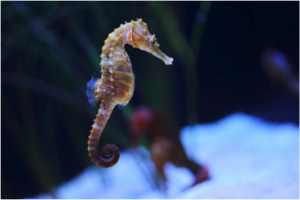There is a whole world underwater! There are so many creatures that swim, play, eat and breath underwater. Let’s put on our diving gear and go explore.
Dolphins
Dolphins may be some of the most lovable creatures in the sea. They are incredibly intelligent and very social. Dolphins hunt and travel in large groups called pods. They usually keep the younger dolphins in the center of the pods to help protect them from predators, such as sharks.
Even though dolphins live in water they cannot breath underwater. Dolphins must come to the surface of the water for air.
Dolphins are also known to migrate. Migrate means to travel long distances to find food or shelter. Dolphins will move around to find a place that has enough food. If an area becomes too polluted or doesn’t have enough food, a pod will not return.
Sea Turtles
Sea turtles live their whole lives in the ocean except for when they come to shore to make nests and lay eggs on sandy beaches. Baby sea turtles hatch on their own and make their way to the ocean by themselves.
There are different types of sea turtles and some can grow to weigh up to 1,000 pounds!
Most sea turtles are endangered. That means there are not very many of them left alive. Many are caught accidentally or their habitats are too polluted to survive. Scientists aren’t sure how long sea turtles can live in the wild, but they think they can live to be 100 years old or more!
Jellyfish
 There are many different kinds of jellyfish throughout the ocean. Jellyfish are called jellyfish because they don’t have any bones so they look and move like jelly. They often have long tentacles. Some jellyfish have tentacles that can cause a painful sting. Jellyfish use this to protect themselves from predators.
There are many different kinds of jellyfish throughout the ocean. Jellyfish are called jellyfish because they don’t have any bones so they look and move like jelly. They often have long tentacles. Some jellyfish have tentacles that can cause a painful sting. Jellyfish use this to protect themselves from predators.
Jellyfish are often found in blooms. That means a large gathering of jellyfish. Jellyfish cannot swim well so they float on ocean currents. When currents come together there can be very large blooms of jellyfish.
Seahorse
 Seahorses are unique fish that are long and skinny with a tail that curls around. Seahorses can use their tail to grab onto grasses so they won’t be washed away by currents. These fish have long skinny snouts that they use to slurp up food.
Seahorses are unique fish that are long and skinny with a tail that curls around. Seahorses can use their tail to grab onto grasses so they won’t be washed away by currents. These fish have long skinny snouts that they use to slurp up food.
Seahorses have excellent eyesight. Each eye can move separately from each other so that means they can look forward on one side of their head and backwards on the other side of their head. This helps them find food.
Seahorses can also change color so that they can blend in with their surroundings. They are very good at blending in because they can also grow parts on their bodies called cirri. Cirri look like seaweed and helps the seahorse hide. These adaptations help protect them from predators.
Octopus
Octopus are known for have eight legs. Like seahorses octopus are excellent at disguising themselves. They can change shape, color and even pattern to match the rocks and seaweed around them. Most predators will pass right by them. If they are discovered, an octopus can squirt ink at their predators. The ink will block the vision of the predator so the octopus can swim away. Octopus are very fast swimmers, so a predator will probably not be able to catch up. An octopus can also squeeze into tiny cracks so that predators cannot reach them.
Octopus have sharp beaks they use to eat food, but they can also be used for defense if they need too. Octopus have many great features that can help them stay safe in dangerous waters. Can you imagine having eight legs?!
A World of Water
71% of the world is covered with water. That means more of the world is water than land. There are so many creatures that live in the water throughout the world. Many have spectacular and strange features like eight legs or massive shells. Many of these features are used for camouflage or to protect themselves from predators in other ways. To find out more about animals that use camouflage listen to this song about Stripes the tiger!
Sources
